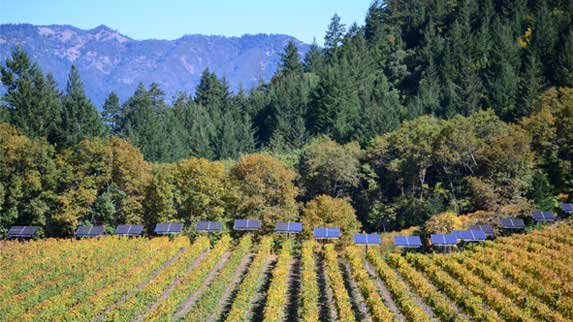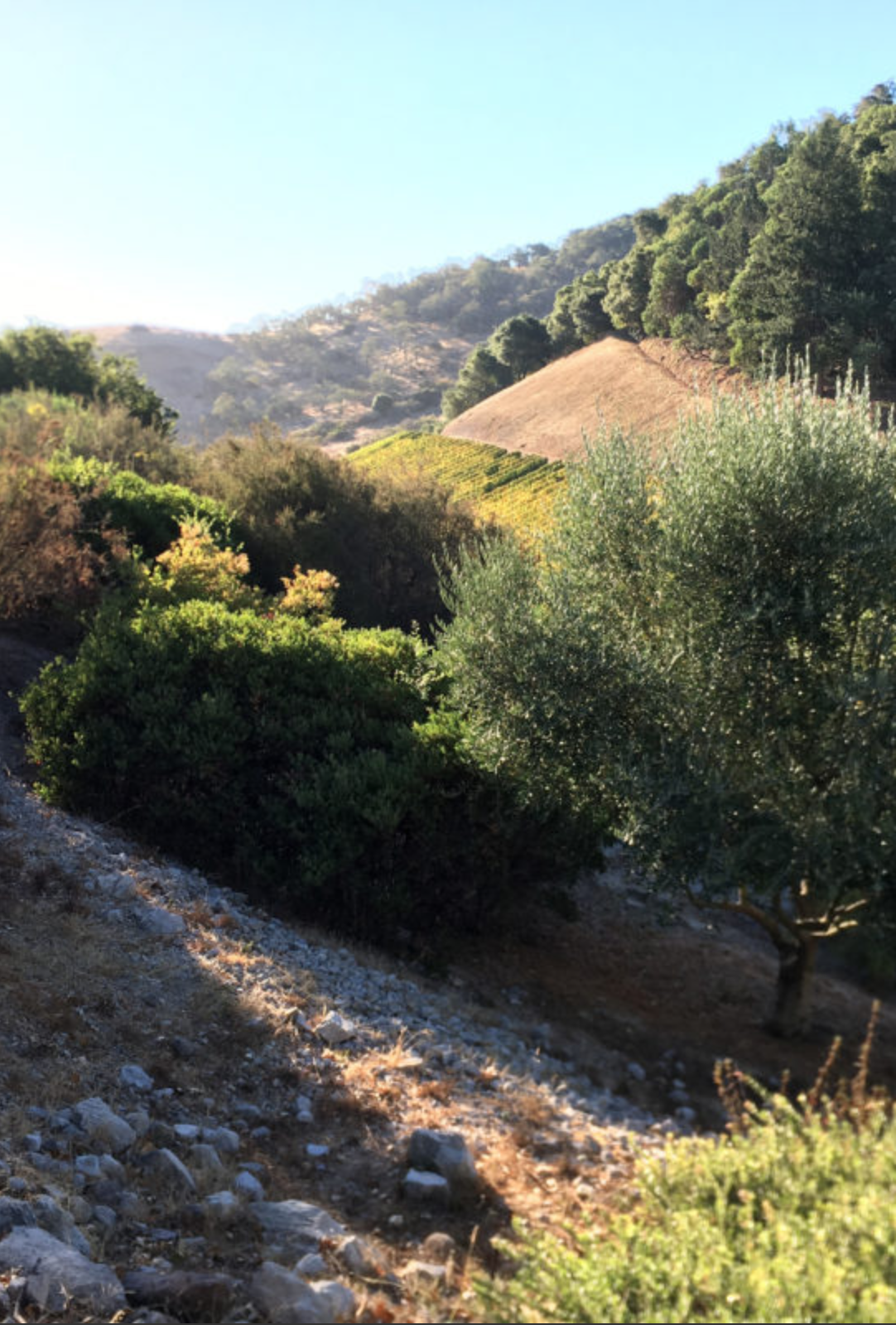
Merlot grapes at Chateau Monbousquet in St. Emilion. Photo: Chateau Monbousquet
October is National Merlot Month! Regrettably, there are no days off work associated with this celebration. Unless, perhaps, you drink too much of it. But still, it’s a good excuse to read up on Merlot.
There are many fabulous Merlot wines on the market. But, in the United States, Merlot is still trying to shake a reputation for being too soft, too fruity and too boring. That reputation was earned mostly by producers growing too much, in too many wrong places, and going for mass market sales.
If the goal was vigorous profits, that recipe wasn’t necessarily off the mark. Though the movie Sideways portrayed Pinot Noir as the antithesis to Merlot, consumers are now buying loads of soft, fruit, sweet Pinot (and red blends).
So, don’t hate the grape. Those of us who love great wine, wines of balance with tannins, acidity, fruit and savoriness tugging at opposing corners to create a taut, exciting glass of red, can find Merlot to fit the bill from hundreds of careful producers in dozens of high-quality wine regions.

The Keenan Mailbox Merlot Vineyard on Spring Mountain in Napa Valley. Photo: Keenan
What you should know about Merlot
Merlot isn’t a very old variety. Surprisingly, given how popular and widespread it is, the first written reference to Merlot came in the early 18th century. It was spelled “Merlau” in that text, which referred to the excellent wine it made in the area of Libourne, on the Right Bank of Bordeaux.
Merlot and Cabernet Sauvignon share a parent. Just 20 years ago, DNA researchers determined that Cabernet Franc was the male parent of Merlot, as it was for Cabernet Sauvignon. Uncovering its mother proved difficult, as the variety in question turns out to be very obscure. But, about 10 years ago, scientists happened upon a few scattered plantings of the mysterious grape they now refer to as Magdelaine de Noire des Charentes in Brittany and in Charentes, just north of Bordeaux.
Merlot is the second-most planted wine grape variety in the world with roughly 660,000 acres. That’s about 180,000 fewer acres than Cabernet Sauvignon, but 90,000 more than Tempranillo, the third most-grown grape.
Merlot makes dark, fruity wines, but ripens relatively easily. This is the main reason so many regions grow it. Merlot makes good wines in places where Cabernet Sauvignon doesn’t mature sufficiently or faces disease pressure late in the year. With the climate warming, even Germany is planting Merlot now.
Managing Merlot’s vigor is key to making excellent wine. Because it buds early, ripens well, and likes to grow, vigneron may be tempted to enjoy high yields. But that can lead to nondescript fruit which lacks structure and may even have unpalatable green flavors. A more measured approach in the vineyard leads to attractive ripeness, complex and concentrated flavors, impressive structure, and gently mouthwatering acidity.
There are many ways to manage vigor. Cool to moderate climates help, as do fewer hours of bright sun, either due to facing, short days, or cloud cover. Soils that retain moisture, such as clay, keep vine roots cool, which slows ripening and can reduce vigor. But you don't want too much water. Limiting vines' access to water is another way to keep vigor under control. There are various pruning and vine training regimes that help too.
There are more acres of Merlot in France than of any other variety. It’s the dominant grape in Bordeaux, despite the attention Cabernet Sauvignon receives, and also Bergerac. Languedoc is second-biggest growing region for Merlot in the world, with 74,000 acres. That’s significantly more than the country of Italy and the state of California, which are the third and fourth most significant growers.
Much, but by no means all, of the volume in Languedoc goes for broadly commercial wines, rather than ones focused on top quality. That is also the case in Bulgaria and Moldova, the fifth and seventh largest growers. Chile and Australia, the sixth and eighth largest, make both mass market and high-quality Merlot.
Among the regions with excellent expressions of Merlot are the Right Bank of Bordeaux, Tuscany in Italy, Napa Valley in California, Washington State, plus Australia’s Margaret River, Coonawarra and Yarra Valley.
Our article about Petrolo Galatrona describes their unique Tuscan expression in detail.

The Blankiet Estate plantings of Merlot are on sloping, rocky clay soils in the Mayacamas mountain range, mostly with shady north and northeast facings. Photo: Blankiet
Here are some of the amazing Merlot varietals and blends, from various regions, offered by JJ Buckley:
Pomerol, Bordeaux, FR
2016 Enclos Tourmaline Merlot
2017 Chateau Petrus
2017 Vieux Certan
2014 Clinet
2015 Fleur de Gay
St. Emilion, Bordeaux, FR
2014 Pavie-Macquin
2012 Troplong-Mondot
2015 Monbousquet
1998 Cheval Blanc
Tuscany, IT
2015 Tenuta dell'Ornellaia Masseto
2014 Petrolo Galatrona
2015 Tua Rita Redigaffi
2013 Castellare di Castelilina Poggio Ai Merli
Napa Valley, USA
2014 Blankiet Rive Droite
2014 Pahlmeyer Winery Merlot
2014 Keenan Merlot Mailbox Vineyard Spring Mountain Reserve
2014 Shafer Vineyards Merlot
Washington State, USA
2015 Leonetti Cellar Merlot
2014 Pedestal Merlot
JJ Buckley guest blogger Fred Swan is a San Francisco-based wine writer, educator, and authority on California wines and wineries. His writing appears in The Tasting Panel, SOMM Journal, GuildSomm.com, Daily.SevenFifty.com, PlanetGrape.com, and his own site, FredSwan.Wine (formerly NorCalWine). He teaches at the San Francisco Wine School. Fred’s certifications include WSET Diploma, Certified Sommelier, California Wine Appellation Specialist, Certified Specialist of Wine, French Wine Scholar, Italian Wine Professional, Napa Valley Wine Educator and Level 3 WSET Educator. He's twice been awarded a fellowship by the Symposium for Professional Wine Writers.
Copyright JJ Buckley 2018.